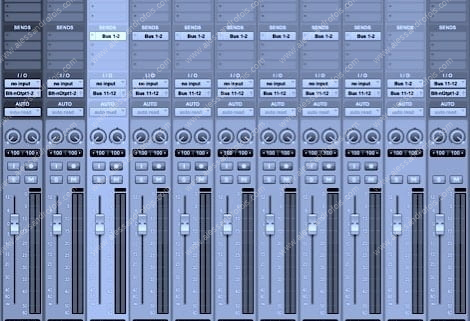Stem Mastering - The rules for a correct process
- Author Profile
- Recent posts
Pianist, Composer, Arranger, Sound Engineer, Writer, Blogger
Alessandro Fois is a musician, composer, pianist, arranger and sound engineer. Since 2018, he has also been a writer, blogger and webmaster. He currently resides in Ivrea (Turin) where, in addition to the above activities, he manages Lycnos, studio for audio, video and web services, and the recording studio Glamour Recording Studio.
NOTE
This article can be considered a continuation of an earlier introductory article, entitled:
Stem Mastering - Basic Principles
Which stems
Gang of Four
One possibility, suggested by sound engineer Bob Katz and applicable to most pop-rock, funky, dance and similar genres, is the simple division into four stems', which he dubbed The Gang of Four:
- Stem 1 - Whole Mix
- Stem 2 - Tools
- Stem 3 - Instruments + Choirs
- Stem 4 - Lead Voice or Solo Instrument of the song
Considering the possibility of using stems additively or subtractively, it will be easy to imagine the simple operations that can be achieved.
Example
Suppose, for example, that in the mix the voice sounds too loud, not enough body and too compressed. With stem no. 4 used with reverse polarity, we can subtract a lot of volume from the voice even to the point of making it disappear. With another track with the same stem 4, but used in straight polarity, we can feed the vocal track back into the audio programme at the desired volume, taking care to give the track more body and a hint of expansion to counteract excessive compression.
Magnificent Seven
You will forgive the 'conceptual game' with the 'Gang of 4', in defining the choice that follows by the name 'The Magnificent 7'.
I personally believe, in fact, that in some cases it would be better to operate with a few more stems:
- Stem 1 - Whole Mix
- Stem 2 - All instruments
- Stem 3 - Instruments + Choirs
- Stem 4 - Voice or Soloist of the song
- Stem 5 - Bass
- Stem 6 - Bass drum
- Stem 7 - The instrument (or group of instruments, or session of instruments) that best defines the rhythmic harmonic bearing of the song (often an acoustic or electric guitar or piano, but sometimes it can also be a synth, string quartet or other).
In this way, in addition to the stems suggested by Bob Katz, other elements will be available, including particularly critical ones that are expressed at low frequencies, such as the bass and kick drum.
By using additive and subtractive processes, we will be able to resolve many of the imbalances in the mix very well.
Note
In special cases, it is not excluded that the mastering operator may request a single source or a group of sources not listed above. This can happen if the source or group in question manifests a disproportion in tone or volume with the context
Advantages of Stem Mastering
It allows ample scope for intervention by the mastering engineer in order to best resolve any mix-induced distortions.
In many cases where a single track mastering was planned, a Stem mastering had to be carried out in order to check and fix some flaws in the mix.
Risks of Stem Mastering
The risk is to slightly distort the overall 'flavour' of the original mix, especially if many tracks are involved. For this reason, it is advisable that it is carried out in the presence of the production manager.
How to export stems correctly
A foresighted mix engineer should take care, at the time of bouncing, to also export an appropriate number of stems. By doing so, he would protect himself against the risk of having to make revisions to the mix or even simply having to export the stems requested by the mastering engineer later.
It is strange to note that not all sound engineers know how to export stems correctly, in the absence of previous experience of this kind. To summarise, the correct export of a stems produces a file whose audio programme is perfectly identical to that of the same source immersed in the mix including the reverb fields, without variations in volume, tone and dynamics.
Note
It is also possible to proceed with a reverberation-free stem, which will allow full control over the source but not over the reverberation fields. In this case, for example, a subtractive action will not eliminate source reverberation.
The use of a stereo stem within the M/S matrix will finally give us the possibility of diminishing to a good extent the incidence of reverberation of the stem itself, simply by lowering the volume of the S component of the matrix.
The export procedure is very strict but simple, but it is easy to lose control of some details, making the stem almost unusable in many applications.
Basic rules
The tracks, whatever they are, must be exported once the mix is perfectly defined.
Synchronised stems are obtained by starting and ending the export at the same point on the timeline, similarly to the complete mix.
You simply have to mute any tracks that you do not wish to export.
This mode of operation forces any reverb or other process that has been applied to the entire mix to be reflected in the stems. In certain cases, however, the export of a stem of the reverb alone may be required.
In order to maintain the balance of the original mix, it is absolutely necessary that all tracks routed to the same bus are exported as a single stereo element (this recommendation is particularly important if a dynamics processor is operating in the group and an effects return is present in it.
In additive correction, but even more so in subtractive correction, the mix between the complete track and a single stem will only work satisfactorily provided that the stem corresponds 'perfectly' to the same source inserted into the mix.
In comparison to the corresponding track immersed in the mix, the stem works very well:
- must contain the same stereo reverb (so the stem will also be stereo)
- shall not interact via the control of a sidechain compressor
- must have undergone the same equalisation, compression and other processes, if any, by means of the same plug-ins
- must have the same volume
- must be positioned in the same position in the stereo image, by means of the pan-pot
- must also be identical with regard to the variations imposed by the automatisms programmed by the mix sound engineer, both for the volume function and for all others
- must not be part of a group or bus in which dynamic control processes of several sources have taken place, as such processes would create a dynamic interaction with the other sources contained therein, making the stem different from the corresponding source contained in the mix; for the same reason, any dynamic intervention on the master track will also be prohibited
If one or more of the above elements are not fulfilled, there may be a partial effectiveness in the use of additive techniques and a total inability to use subtractive ones.
Finally, it should be borne in mind that the coloured filters used in a stem, particularly those of analogue emulation, will often not be able to guarantee at each export cycle a waveform perfectly identical to the previous ones, which could diminish the effectiveness of the process especially in subtractive use (but not only)
For more on Digital Audio Mastering






Leave a Reply
Want to join the discussion?Feel free to contribute!